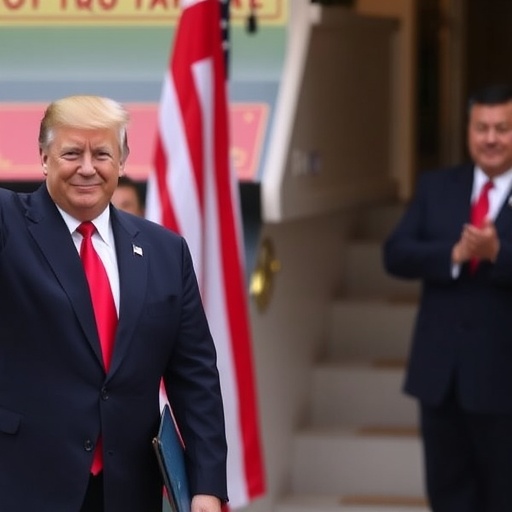In a bold move to reshape global trade dynamics, President Donald Trump has embarked on a high-stakes tour of Asia, aiming to lock in lucrative trade deals with key allies while capitalizing on fresh momentum in negotiations with China. The trip, kicking off this week, underscores Trump‘s aggressive foreign policy approach, blending diplomacy with economic leverage to counterbalance Beijing’s influence in the region.
Trump Lands in Japan: Reviving Bilateral Trade Ties
President Trump’s first stop on his Asia itinerary is Tokyo, where he is set to meet with Japanese Prime Minister Fumio Kishida to discuss expanding a revised version of the U.S.-Japan Trade Agreement. Signed in 2019, the pact has already boosted American agricultural exports by 25% to Japan, according to U.S. Department of Agriculture data. But Trump is pushing for more, eyeing sectors like semiconductors and electric vehicles amid rising tensions over supply chain vulnerabilities.
“Japan is a vital partner in our fight for fair trade,” Trump declared in a pre-trip statement from the White House. “We’re going to make deals that benefit American workers first and foremost.” Sources close to the negotiations reveal that discussions could lead to tariff reductions on U.S. autos, potentially saving the industry billions annually. This comes as Japan grapples with its own economic slowdown, with GDP growth dipping to 1.3% in the latest quarter, making Trump’s visit a timely opportunity for mutual gains.
The talks aren’t without friction. Japanese officials have expressed concerns over Trump’s proposed 10% universal tariff on imports, which could hike costs for their electronics giants like Sony and Toyota. Yet, analysts see the visit as a chance to deepen the security alliance, including joint military exercises in the South China Sea, tying trade deals to broader foreign policy objectives.
Breakthrough Signals in U.S.-China Trade Talks
As Trump jets across Asia, parallel progress in U.S.-China negotiations is stealing headlines back home. High-level talks in Geneva last week yielded what diplomats are calling a “framework agreement” on intellectual property rights and market access, marking the first substantive thaw since the 2018 trade war escalation. Under the deal, China has committed to purchasing an additional $50 billion in U.S. goods, including soybeans and energy products, over the next two years.
White House trade advisor Robert Lighthizer, who led the Geneva sessions, hailed the development as “a win for American innovation.” In a briefing, he noted that enforcement mechanisms will include snap audits of Chinese firms accused of tech theft, a persistent sore point in bilateral relations. This follows a series of virtual summits where both sides exchanged concessions, with the U.S. agreeing to ease some restrictions on Huawei’s 5G equipment in non-sensitive markets.
Economists are cautiously optimistic. A report from the Peterson Institute for International Economics projects that finalizing this deal could add 0.5% to U.S. GDP growth by 2025, while reducing the trade deficit with China by 15%. However, critics argue it’s a temporary fix; Senator Elizabeth Warren tweeted, “Trump’s foreign policy is all flash—no substance on holding China accountable long-term.” The negotiations’ success could set the tone for Trump’s meetings with other Asian leaders, signaling to allies that Washington is serious about countering China’s economic dominance.
Behind the scenes, the talks reveal Trump’s signature deal-making style. Insiders say he personally intervened via phone with Chinese President Xi Jinping, leveraging personal rapport built during their 2017 Mar-a-Lago summit. This human element, combined with data-driven arguments—such as the $300 billion annual cost of the trade imbalance—has reportedly moved the needle.
South Korea and Vietnam: Allies Eye Expanded Trade Partnerships
Moving beyond Japan, Trump’s agenda includes stops in Seoul and Hanoi, where he aims to fortify trade deals with South Korea and Vietnam. In South Korea, the focus is on updating the 2012 U.S.-Korea Free Trade Agreement (KORUS), which Trump renegotiated in his first term. Recent data shows U.S. exports to South Korea surged 18% last year, driven by semiconductors and pharmaceuticals, but Trump wants deeper access for American steel and autos.
South Korean President Yoon Suk-yeol, facing domestic pressure from a sluggish economy with unemployment at 3.7%, welcomes the overtures. “Strengthening ties with the U.S. is key to our prosperity,” Yoon said in a joint press release. Discussions may include joint ventures in battery technology for electric vehicles, aligning with the global shift to green energy. This could create thousands of jobs in rust-belt states like Michigan, where auto manufacturing employs over 200,000 workers.
In Vietnam, Trump’s visit highlights a burgeoning partnership. Bilateral trade has exploded from $50 billion in 2018 to over $120 billion today, per U.S. Census Bureau figures. Trump is pushing for a comprehensive trade deal that would reduce Vietnam’s tariffs on U.S. apparel and machinery, while addressing concerns over currency manipulation. Vietnamese leader Nguyen Phu Trong has signaled openness, viewing the U.S. as a counterweight to China’s territorial claims in the South China Sea.
These engagements reflect Trump’s broader foreign policy vision: using trade deals to build a coalition against Chinese expansionism. A State Department official noted, “Asia isn’t just about economics—it’s about securing our strategic interests.” Yet, challenges loom, including Vietnam’s human rights record, which could complicate congressional approval of any new pact.
Economic Ripple Effects: Boost for U.S. Farmers and Manufacturers
The potential outcomes of Trump’s Asia tour extend far beyond diplomatic handshakes, promising tangible benefits for the U.S. economy. Farmers in the Midwest, hit hard by previous trade disruptions, stand to gain most from renewed Chinese purchases. The American Farm Bureau Federation estimates that the $50 billion commitment could stabilize soybean prices, which have fluctuated wildly since 2018, providing relief to producers in states like Iowa and Illinois.
Manufacturers are equally enthusiastic. The National Association of Manufacturers reports that diversified supply chains in Asia could cut production costs by 10-15% for electronics and machinery. Trump’s push for ally-specific deals aims to shift sourcing away from China, reducing reliance on a single adversary. For instance, a new Japan agreement might relocate chip production, addressing the 2021 global shortage that cost the U.S. auto industry $210 billion.
Statistics paint a vivid picture: U.S. exports to Asia totaled $650 billion in 2023, up 12% from pre-pandemic levels, per Commerce Department data. Trump’s foreign policy, often criticized for its unpredictability, has arguably accelerated this growth through targeted tariffs and incentives. However, experts warn of risks; a Moody’s Analytics study suggests that if talks falter, retaliatory measures from China could shave 0.3% off U.S. growth.
Stakeholders are vocal. “These deals mean jobs coming back home,” said U.S. Chamber of Commerce President Suzanne Clark in an op-ed. On the flip side, labor unions like the AFL-CIO caution against deals that might offshore more work, urging stronger worker protections in any agreements.
Navigating Geopolitical Tensions: Asia’s Balancing Act
Trump’s tour unfolds against a backdrop of escalating geopolitical frictions, particularly in the Taiwan Strait and the Indo-Pacific. His trade deals are intertwined with foreign policy goals, such as bolstering the Quadrilateral Security Dialogue (Quad) with Japan, Australia, and India. Recent U.S. intelligence reports highlight China’s military buildup, prompting Trump to frame economic ties as a deterrent.
In meetings, Trump is expected to rally allies on issues like technology export controls. A proposed “Chip 4” alliance with Japan, South Korea, Taiwan, and the U.S. could dominate semiconductor production, sidelining China. This aligns with the CHIPS Act, which has allocated $52 billion to domestic manufacturing.
Allies are walking a tightrope. Japan and South Korea, economically intertwined with China, must balance U.S. pressures. Vietnam, meanwhile, benefits from the U.S.-China rivalry, attracting factories fleeing Beijing’s zero-COVID policies. A Brookings Institution analysis notes that such shifts have already created 100,000 U.S. jobs indirectly through reshoring.
Trump’s rhetoric adds spice: “China’s been ripping us off for decades—time to even the score,” he posted on Truth Social. This unfiltered style energizes his base but risks alienating partners who prefer subtlety.
Looking ahead, the tour’s success could pivot U.S. foreign policy toward a more assertive Asia strategy. If deals materialize, expect follow-up summits in 2025, potentially including ASEAN nations. Failure, however, might embolden China, prolonging the trade standoff. As Trump wraps up his visits, the world watches: will these negotiations herald a new era of balanced trade, or deepen divisions? The stakes, for America and Asia alike, couldn’t be higher.







